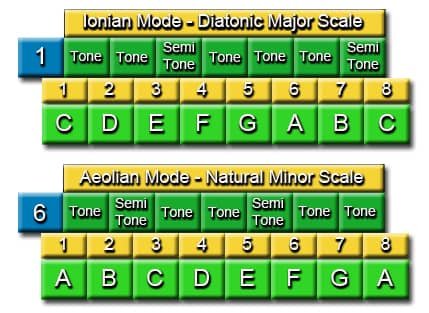Ionian and Aeolian Music Modes: Major and minor Scale
The Greek Modes, Modal Scales or Music Modes, are based on the C major scale. The major scale is called the Ionian Mode or Diatonic Major scale. Scale from which the rest of the Greek modes would flow. So we just have to memorize the structure of the Major scale in the fretboard, and from it the minor scale would flow, and the rest of the music modes.
This modal scales thing would be similar to always dressing in the same suit, but changing the order when we put on the different clothes.
For example, if instead of setting up the C Major scale as C – D – E – F – G – A – B – C, we set it up as A – B – C – D – E – F – G – A, we will already have passed from the Ionian Mode or major scale in the key of C, to the Aeolian Mode or natural minor scale in the key of A.

Although the order of the intervals of each mode has varied, obtaining two different scales in two different keys, its structure is not altered, since both scales are made up of the same notes.
For this reason, the 6th note of a major key is called relative minor.
The Most Used Greek Modes of Modern Music
The two modes mentioned above are the most used in modern music. Used in most songs, and in the most popular musical genres.
On the left of the graph below, we have the scales in the basic tonality that corresponds to each mode, and on the right we have those same modes but in the same key (C), to be able to appreciate the differences of each.
The modes that have the notes in a green box are the diatonic Major scale (Ionian Mode – 1st), and the natural minor scale (Aeolian Mode – 6th). We already saw these scales in the sections on Music Intervals, and in Notes of the Major and Minor scale.
Locrian Mode or B Mode
The Locrian Mode (7th) is at the end of the following diagram, and the notes appear in an orange box. This mode is a scale that is not usually used in occidental music, although it is mainly part of Indian and Japanese music.
All Music Modes

Having discarded the Ionian, Aeolian and Locrian modes, we will now see the four remaining Greek modes.
Music Modes: Dorian Mode or D Mode
The Dorian Mode or D Mode is a minor mode that would come from the 2nd note of a Major scale, and the only difference that exists with respect to the natural minor scale is that the 6th note is a semitone higher (see Aeolian mode, above). Mode used in genres such as Funk or Jazz.

Phrygian Mode or E Mode
The Phrygian Mode or E Mode is also a minor mode, and would come from the 3rd note of a Major scale. Its difference from the natural minor scale is that the 2nd note is a semitone lower (see Aeolian mode, above). This mode has a jazzy feel.

Musical Modes: Lydian Mode or F Mode
The Lydian Mode or F Mode is a Major Mode that would come from the 4th note of a Major scale, and its difference with respect to the Major scale is that the 4th note is a semitone higher. Mode used in Pop and alternative music.

Mixolydian Mode or G Mode
The Mixolydian Mode or G Mode is a Major mode that would come from the 5th note of a Major scale, and the only difference with respect to the Major scale is that the 7th note is a semitone lower. After the diatonic major scale and the natural minor scale, this would be the most important scale in terms of use. Used in many musical genres such as Pop, Blues, Rock and alternative music.

How to Play in a Specific Greek Mode
Let’s say for example that we want to search for the notes that make up the key D in Mixolydian mode. The Mixolydian mode is a Major mode, so we have to look in the Key chart of the Major scale (if we wanted to look up the notes of a minor mode, we would have to look in the natural minor scale chart). Those notes are:

As I have already mentioned, the difference between the Mixolydian mode and the Major scale is that the 7th note is a semitone lower, so it would look like this:

These are the notes of the key of D in Mixolydian Mode.
What Relative Scale to Use to Play in a Specific Greek Mode (Example for D Mixolydian)
If we have the structure of the Major scale memorized on the fretboard, we have to look for the scale in which D is the 5th note. Since the Mixolydian mode is a mode based on the 5th note of the Major scale. If we wanted to look for the scale for the Dorian mode, for example, it would have to be the 2nd (it is specified in the mode charts), and again we have to look in the keys chart of the Major scale. That scale would be G:

As you can see, they are exactly the same notes that we had before (table above). In this way, we already have a reference to a better-known scale (G Major), although the notes are disordered. To keep them in order we just have to take D as the 1st or Tonic, and that’s it.
Therefore, we can do a guitar solo within the G Major structure in the fretboard. But taking D as the tonic, G as the 4th, and A as the 5th (see table above), and we would be playing in D Mixolydian.
